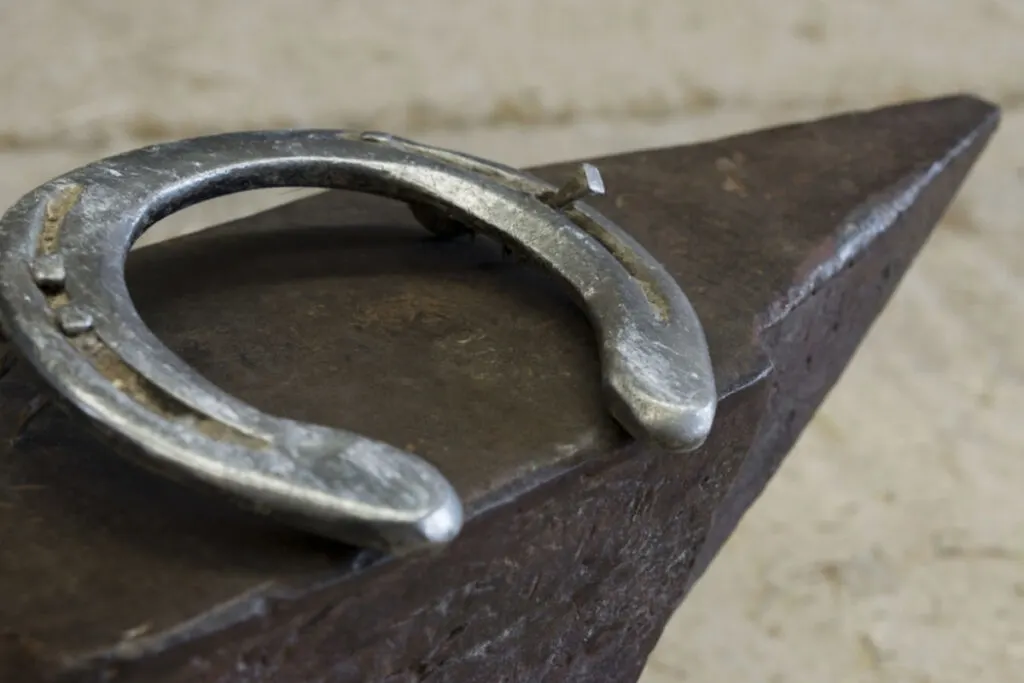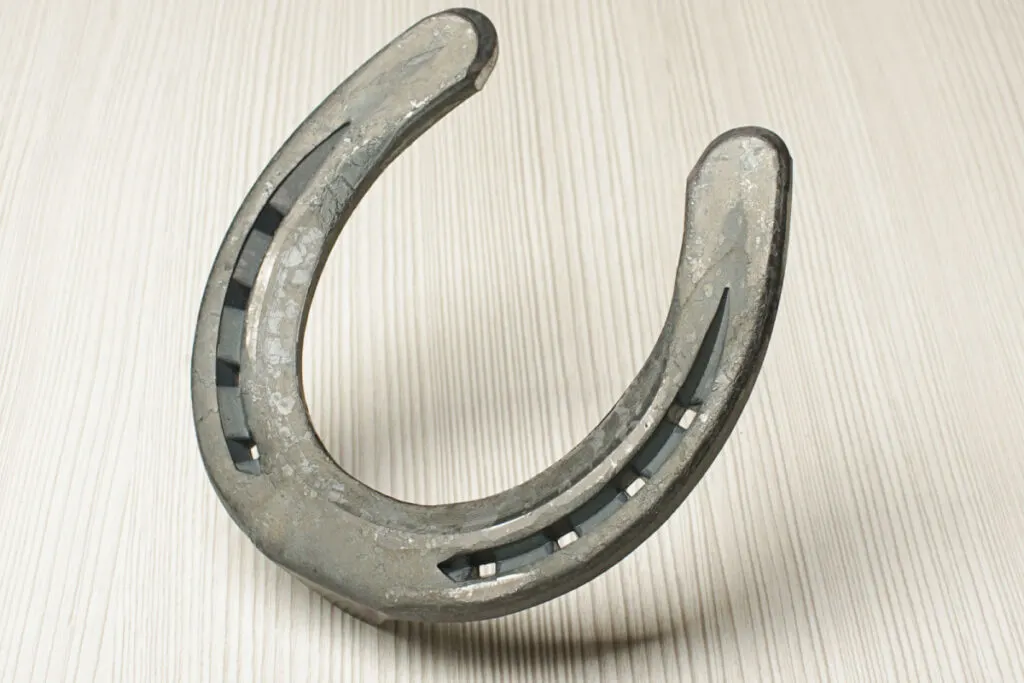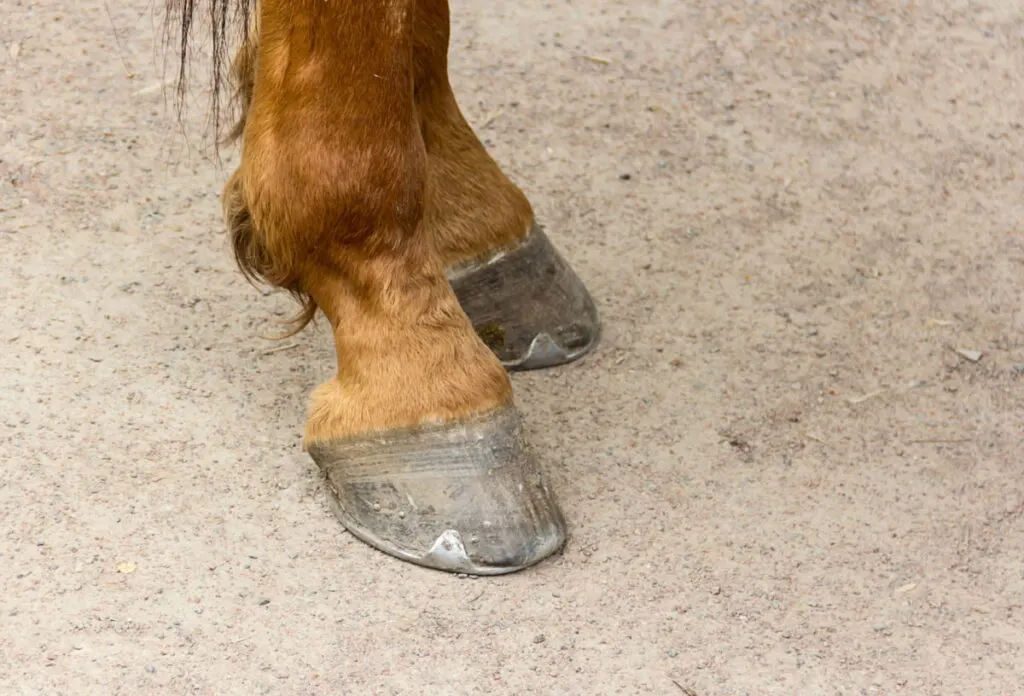Horseshoes are important for the health of a horse’s hooves, especially if their hooves are prone to cracking or other injuries.
Horseshoes help protect a horse’s hooves from excessive wear and are vital for horses that participate in sports or even trail riding.
There are more options that just the regular u-shaped horseshoe most people are familiar with.
Sure, the basic horseshoe is used by farriers most often and it serves its purpose well, but there are several different types of horseshoes that exist today.

Table of Contents
Horseshow Materials
Horseshoes can be made using a variety of materials. Typically, most horseshoes are made using steel or aluminum materials.
Steel horseshoes are heavier than aluminum, but that last longer and are more tailored toward high activity sports like show jumping, barrel racing, roping, team penning, and polo.
Aluminum horseshoes, due to their lighter weight, are more ideal for dressage events. Specialty shoes can be made from rubber, copper, plastic, and even titanium.
Types of Horseshoes
Here are the most common and essential types of horseshoes available for your favorite equine friend.
1. Regular Keg Shoe

Type: Standard
Front or Back: Either
Cost: $3-5 per shoe
A regular keg shoe, also called a u-shape or a basic horseshoe, is the most used and well-known horseshoe. It is a simple flat shoe that has holes punched in it for nails.
The back of the horseshoe is left open and sits over the heel of the hoof. Basic horseshoes are used on healthy hooves that do not need any special considerations or care.
The farrier will hammer nails in the shoe to attach it to the hoof. Basic keg horseshoes are usually made from steel but can be made from aluminum.
They will last around 4 to 6 weeks on average before they need to be replaced.
2. Rim Shoes
Type: Standard
Front or Back: Either
Cost: $4-5 per shoe
Rim horseshoes look almost identical to basic keg horseshoes, but there is one key difference.
There is a deeper crease around the nail holes creating a higher ridge that gives the horse better traction when running.
Rim horseshoes are ideal for horses that participate regularly in barrel riding, polo, pole bending, and timed events.
They are most often made from steel, but there are aluminum options available.
3. Clipped Shoes
Type: Standard and Corrective
Front or Back: Either
Cost: $6-8 per shoe
Clipped horseshoes are basic keg or rim horseshoes that also have either a toe clip or 2 to 4 quarter clops.
A toe clip sits at the front curve of the shoe while quarter clips sit on each side. The clips help the shoes stay on the horse’s hooves longer especially if they are prone to losing their shoes.
Clipped horseshoes are also used for horses that are suffering from fractured coffin bones.
Horseshoes that have clips are still attached with nails, but the clips just add additional support and longevity.
4. Sliding Plate Shoes
Type: Specialty
Front or Back: Hind
Cost: $7-12 per shoe
Sliding plate horseshoes, while they look like regular shoes, are anything but basic horseshoes.
They are designed to cover the entire length of the horse’s hoof unlike regular horseshoes. Sliding plate shoes also have different widths toward the heel of the shoe.
This is a specific design element made to enhance the performance of reining horses when stopping suddenly during competitions. Sliding plate horseshoes should only be used on the hind legs of a horse.
5. Racing Plate Shoes
Type: Specialty
Front or Back: Either
Cost: $7-20 per shoe
Racing plate horseshoes are designed specifically for racing horses. They are made to be used for only a couple of days or just enough time to complete the race.
They are made from aluminum to make them as light as possible, so they do not hinder the horse’s racing ability.
The intention is to protect the horse’s hooves but not at the expense of adding too much weight.
6. Heart Bar Shoes
Type: Corrective
Front or Back: Either
Cost: $20-50 per pair
Heart bar shoes are designed with heart-shaped bars enclosing the shoe over the frog area of the horse’s hoof.
These shoes are used temporarily to help distribute weight from the side walls of the hoof to the frog instead.
Heart bar shoes are great for hooves that have cracks or other injuries. The horseshoe will help to take pressure off of a horse’s coffin bone.
Heart bar horseshoes should only be applied by professional horseshoe farriers and under a veterinarian’s care to prevent additional injuries. Heart bar shoes can be made from aluminum or steel depending on the need.
7. Egg Bar Shoes
Type: Corrective and Preventative
Front or Back: Either
Cost: $20-30 per shoe
Egg bar horseshoes are designed in an egg-like shape with a rounded connection at the heel of the shoe.
Their unique shape and closed heel provide extra stability for horses especially those participating in sports like jumping.
They are also helpful for horses that need a little extra posterior support in their hooves.
Egg bar horseshoes increase the amount of posterior flotation as well. They can be made from steel or aluminum material.
- aluminum wedge egg bar horseshoe
8. Straight Bar Shoes
Type: Corrective
Front or Back: Either
Cost: Variable
Straight bar horseshoes have a straight connecting bar on the back of the shoe. These are used on horse hooves that are experiencing cracking, scalping, or cross firing.
Scalping is when the toes of a horse’s front hooves are striking the hooves of their hind legs.
Cross firing is when a horse’s back hooves are connecting with the front hooves when walking or running.
Straight bar horse shoes are not as popular as egg bar shoes, but they are still used in some circumstances.
9. Wedge Shoes
Type: Corrective
Front or Back: Either
Cost: $17-19 per shoe
Wedge horseshoes have lifts in different elevations to help running horses and those that are suffering from navicular issues.
Horses with navicular syndrome, commonly called caudal heel pain, have severe pain in the back part of their hoof that causes lameness.
Wedge horseshoes help raise the horse’s heel and alleviate some of the pain they are experiencing.
For running horses, the wedge shoe helps support the horse’s heel when they run.
10. Glue-On Shoes
Type: Corrective
Front or Back: Either
Cost: $40-75 per pair (includes adhesive kit)
Glue-on horseshoes are used on horse hooves that cannot take a nail for reasons such as wall issues or severe damage.
The shoes are designed to be glued onto a horse’s hooves. They are usually are made from plastic but sometimes can be made with aluminum.
Glue-on shoes do not typically last as long as steel horseshoes and are often more expensive, but they do come in kits along with the glue.
11. Hoof Boots Horseshoe

Type: Corrective
Front or Back: Either
Cost: $50-112 per boot
Hoof boots are used in place of a typical horseshoe and are ideal for horses that cannot wear shoes for various reasons.
Horse hoof boots can be easily attached to a horse’s hooves and just as easily removed. This allows owners to only use the boots when needed and not all the time.
They are also ideal for horses that are suffering from hoof-related issues like laminitis, infections, cracking, and more.
The horse’s hooves will still need to be trimmed and cared for regularly, but a standard horseshoe is not needed if boots are being utilized during rides.
Final Thoughts
There are quite a few different types of horseshoes on the market today and finding the right one for your horse will depend on quite a few factors.
You should always discuss your options with experienced farrier as well as your veterinarian, especially if your horse suffers from hoof issues or participates in sporting events.
Resources
- https://en.wikipedia.org/wiki/Horseshoe
- https://horses.extension.org/sliding-plates/
- https://equimed.com/health-centers/hoof-care/articles/how-do-i-identify-hoof-cracks-and-what-is-the-best-way-to-care-for-them
- https://www.americanfarriers.com/articles/1992-a-horseshoers-approach-to-heart-bars
- https://www.americanfarriers.com/articles/8433-two-reasons-for-egg-bars
- https://ker.com/equinews/leg-interference-problems-horses/

